
How Stephen Gould Scaled Its Capacity by 30% without Making a Single Hire

Mastering your marketing ads will help you draw in leads, make your brand distinguishable, and ultimately increase revenue growth.
Standing out from the competitors in today’s dynamic online marketplace is not an easy task. You should know and apply so many things to your marketing campaigns to make sure that your business will be noticed.
Luckily, there is a large range of marketing channels where you can reach your targeted audience. From SEO, email marketing, and targeting blogs to content marketing and digital advertising.
Digital advertising is a powerful way to find customers and stand out from the crowd. Mastering your marketing ads will help you draw in leads, make your brand distinguishable, and ultimately increase revenue growth.
Don’t know where to start? We’re here to help!
Digital advertising also known as online advertising, internet advertising, or web advertising is a data-driven marketing advertising strategy used to reach potential or existing customers by paying a fee to publish promotional material on digital platforms such as websites, social media, search engines, and any other platform that could be accessed digitally.
The goal of digital advertising is to promote your business, products, or services to increase brand awareness and drive revenue growth.
There are three main types of digital advertising:
In this article, we’ll go through details about the display and search types of digital advertising and teach you how to measure the success of your marketing ads.
Display advertising aka display ads is a type of digital advertising that combines images, video, text, and a URL that links to a website where the potential customer who clicks on it can learn more about your business or buy your products or services. In that type of digital advertising, ads are displayed on a network of online publisher websites.
There are many ad formats. An example of display ads are banner ads, responsive ads, retargeting ads, native ads, and more. They come in a variety of shapes and sizes with the majority of them being rectangular or square in shape. The shape and the size depend on the purpose of your ad and the device on which the ad will be displayed.
Typically, the content of the ads is designed to fit the theme and niche of the host website and the audience preferences. Display ads are commonly placed within the content of the page, at the top, at the bottom, and in the sidebar area.

Visuals grab the consumer’s attention much easier than plain text as they are eye-catching and evoke emotions in people. The human brain is programmed to think visually to such a level that often people cannot imagine things without visuals. That is why the display ads are so powerful. Marketers are leveraging visuals to convey their brand message and inspire action. With display ads, you can get as creative as possible using bright colors, large texts, etc. That helps your business and ads to stand out from the competition and make your brand more recognizable.
Brand awareness is one of the biggest benefits of display ads. A recent study found that brand awareness increased by 21% in campaigns that utilized display ads. Display ads allow you to create awareness of your brand by informing your target audience that your business exists. You can reach potential customers before they know they even need you. Then, by the time they figure it out, you have a greater chance to be their chosen product or service provider as they have already encountered your brand online many times.
Display ads remarketing aka retargeting is focusing on displaying ads to users who have visited your site already but have left without making a purchase. Display remarketing campaigns allow you to reach these potential customers with a personalized message encouraging them to return.
Remarketing is a smart way to connect with those who already know about your product or service and remind them to make a purchase. Studies show that re-targeted customers are 70% more likely to buy your product.
We’ve all been part of a remarketing campaign. For example, let’s say that you have browsed a new kitchen table on a home furniture website. You stop browsing for that and go to search for something completely different on Google. Then, after you open a website or a blog from Google, you find ads for kitchen tables on those web pages from that same home furniture website that you just visited.
Search engine advertising is a type of digital advertising that gets your business found on the search engine result pages (SERPs). It is one of the most popular forms of PPC advertising in which brands pay to have their ads displayed on the top of the search engine results for a particular keyword. Chances are that if you ever conducted a search on Google, you’ve seen a PPC ad and might have even clicked on it. Currently, Google is marking the search ads with a small ‘’Ad’’ symbol to indicate that this result isn’t organic.
Search ads have three main components designed to convince the user to visit the site – a headline, display URL, and description text.
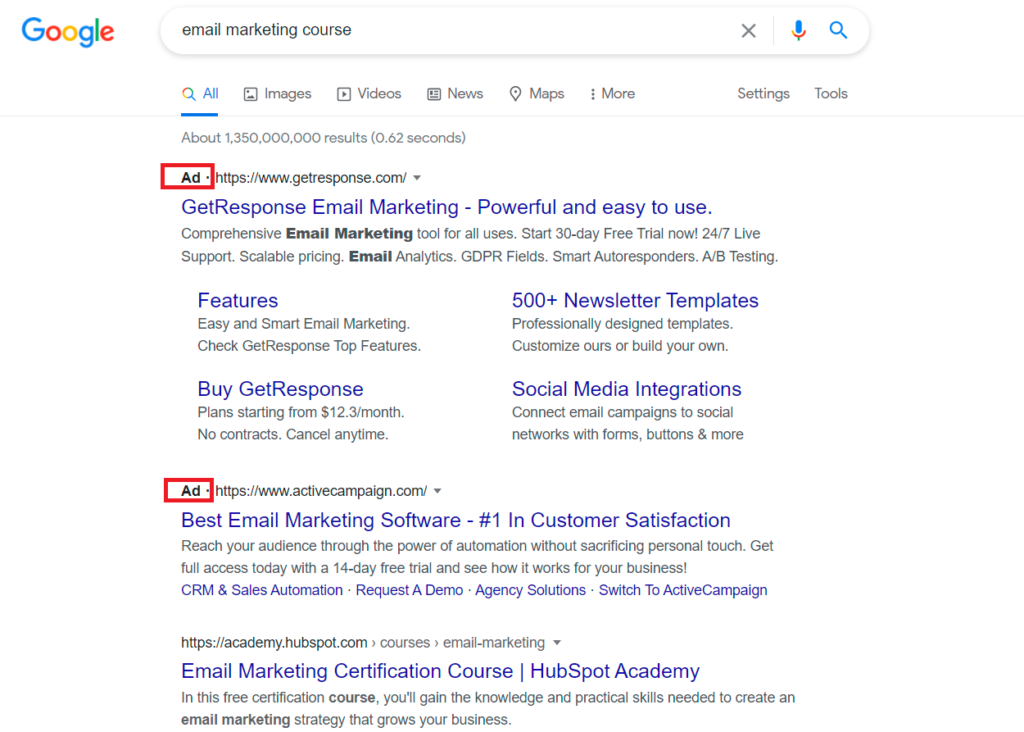
This is a great benefit for those who are just starting out – new companies that are struggling to get their brand in front of the eyes of their potential customers, as well as companies that are targeting specific organic keywords that they aren’t currently ranking for.
Search ads target specific search queries and people that are looking for the solution that you’re offering. Those people who are going to land on your search ads are not just random people surfing the web, but potential customers that are interested in the product or service that you provide.
And when they search for that product or service, you would want to be among the first solutions that they see. By paying for being on the top of these results, you’re guaranteed to be seen by more people. The first page of Google results gets between 71-92% of all traffic, while most people rarely go to the second page.
PPC ads in search results are visually similar to all organic results, so that makes people even more likely to click on them. In fact, is estimated that although ads are marked, about half of the searchers don’t notice the difference between paid and organic search results.
Display ads might be visually appealing, but if users have AdBlock on that doesn’t matter as they won’t be able to see them. Search ads, on the other hand, don’t face the same problem. Although the AdBlock settings could be adjusted to block search ads too, most users don’t bother doing it (if they even know about that option) as they are non-intrusive and are useful.
Get a comprehensive view of any PPC campaign data with our dashboard template.
Use Template →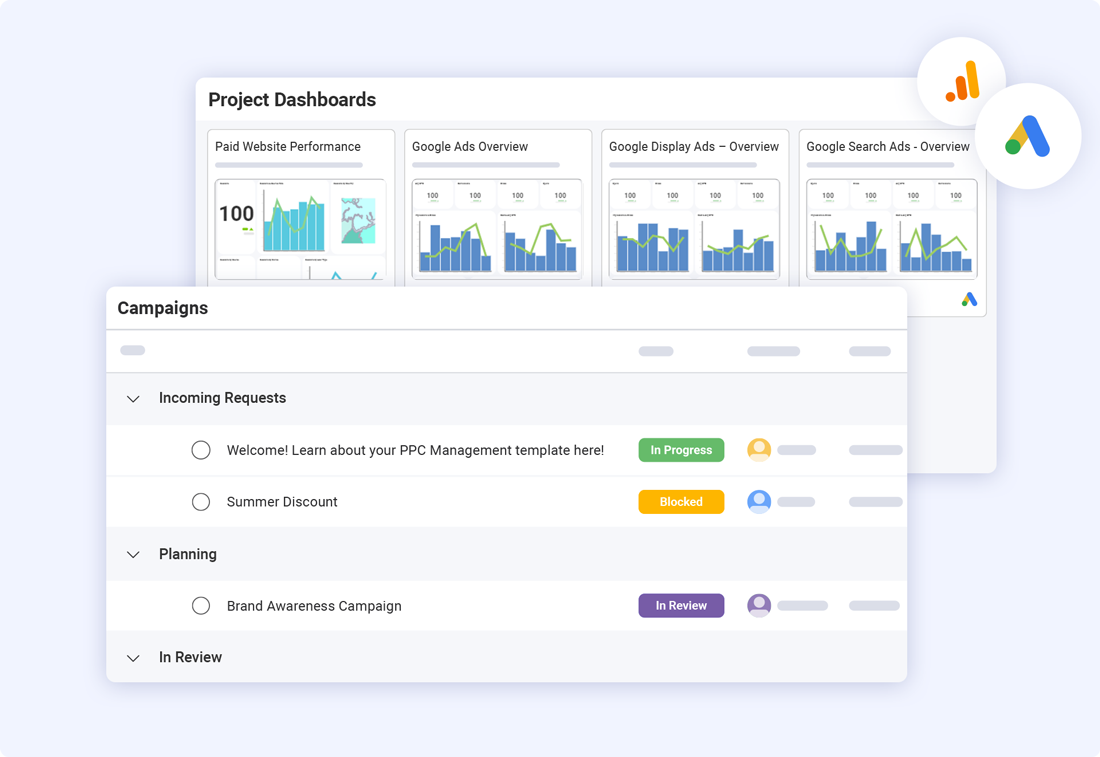
Just like with any other marketing strategy, you’re going to want to track the performance of your display and search ads campaigns to get a clear picture of what’s working and what isn’t. Here are the three most important digital advertising KPIs that you should be measuring:
The CPC measures the actual price that you pay for each click on your ads.
How to calculate your display ads CPC: Divide the total amount spent on your ad campaign by the total number of clicks that occurred.

For example, if you spent $250 on your campaign and 175 people clicked on your ads, your cost per click is then 250 / 175 = $1.43.
The CTR measures the number of users that click on your ads. Set a goal to have a higher CTR than the industry standard. CTR ensures that the message and the journey for your prospects from your ads to the landing page are optimized.
How to calculate your display ads CTR: Divide the number of clicks that your ads receive by the number of impressions.

That formula helps you to determine the percentage of users that are clicking on your ads vs the users that are seeing them.
For example, if 250 people clicked on your ad and 700 have seen it, your click-through rate is then 250 / 700 = 0.36%.
The conversion rate measures the percentage of people that completed the desired action that your ad campaign was aiming for (making a purchase, submitting a form, registering for your website, etc.).
Simply put, the conversion rate helps you find out how good your ad campaign is in getting people to do what you want them to do. The higher your conversion rate is, the better your campaign is. Set a goal to have a higher conversion rate than the industry standard that will help you hit your revenue goals.
How to calculate your display ads conversion rate: Divide the total number of conversions by the total number of clicks on your ads and multiply the outcome by 100.

For example, if 120 people clicked on your ad and 55 of them completed the desired action, your conversion rate is then 55 / 120 = 0.45. You multiply that by 100 and you have a conversion rate of 45%.
According to WordStream, the average cost per click in AdWords across all industries is $0.63 for display ads.
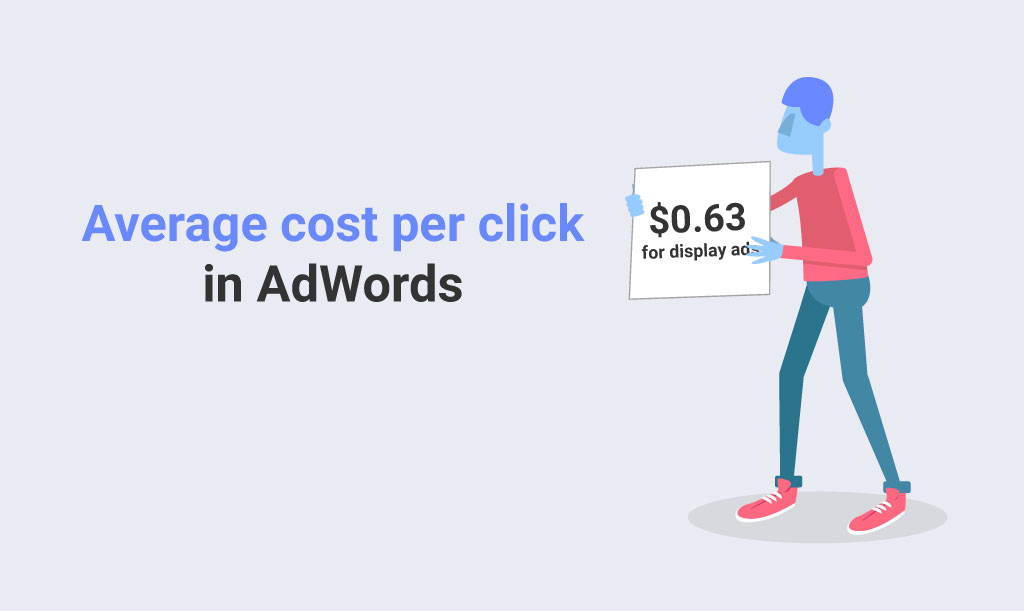
‘’Quality Score is an estimate of the quality of your ads, keywords, and landing pages. Higher quality ads can lead to lower prices and better ad positions.’’ – Google Ads.
To improve your quality score, make your ads more relevant to the keyword that you are bidding on, make your landing page better by using a clear message that aligns with your ad copy, and work on improving your ads CTA.
There is usually lower competition for longtail keywords, and their conversion rate is typically higher.
Geotargeting is basically narrowing down your audience. If your product or service is tailored for a specific group of people who belong to a certain location, age, or gender, then this strategy is not only going to reduce your CPC, but it would also help you reach the right people.
WordStream also found out that the average click-through rate in AdWords across all industries is 0.46% for display ads.
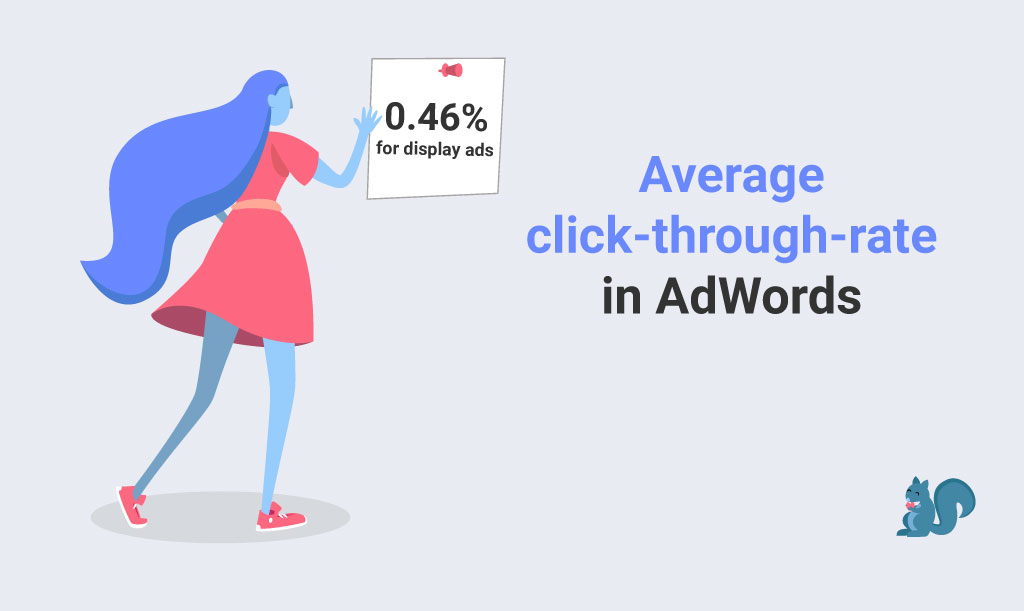
The ad placement can seriously impact your CTR. Studies have shown that ads placed at the top of the page (below the title or the header of the page content) attract significantly higher impressions. In contrast, ads that are placed on sidebars or at the end of the page would likely result in a low CTR.
You can create an ad with some plain text and without including a CTA, but it’s highly advisable that you do, so you can convince the people seeing your ad to visit your site.
You cannot create only one banner for your entire campaign. You should think about different banner shapes and sizes to suit different websites, devices, and media channels. More banners mean a wider reach and more leads.
Mobile is the future of digital advertising. It’s predicted that by 2022 mobile will account for 77.2% of all digital ad spend. The reason for this is that almost half of the online traffic comes from mobile devices, therefore any display ads campaign should focus on them.
Your ad copy should be highly relevant to the keywords and search queries of your audience and should make them want to complete the action that you want them to. But don’t just write clickbait ads as your goal is not only to get more clicks to your ads but to turn the people who click into paying customers.
Let’s imagine that you see an ad, you click on it, and you find something completely different than expected when you land on the landing page. It’s confusing when you promise something that doesn’t become clear to the visitor immediately. If the landing page does not contain what the visitor was looking for, then the visitor will leave the website immediately.
Your landing page should deliver the promise of your ad and make it easy for the visitor to complete the desired action, be it making a purchase, registering for your website, or signing up for a webinar. Aligning the copy of your ad with your landing page is called message match and not only that it improve your conversion rate, but you also spend money on clicks which is meaningless if you cannot make those people who click do what you want them to do.
Having a conversion action from someone who visits your site for the first time is fairly rare. Remarketing helps bring back people who are already familiar with your brand, reminding them why your product or service is so great and persuades them to proceed with the conversion.
The conversion rates are usually higher with remarketing because when you repeatedly show your ads to the people who showed interest in your product or service, you see an increase in conversions when you remind them that you offer what they need.
According to WordStream, the average cost per click in AdWords across all industries is $2.69 for search ads.
WordStream also found out that the average click-through rate in AdWords across all industries is 3.17% for search ads.
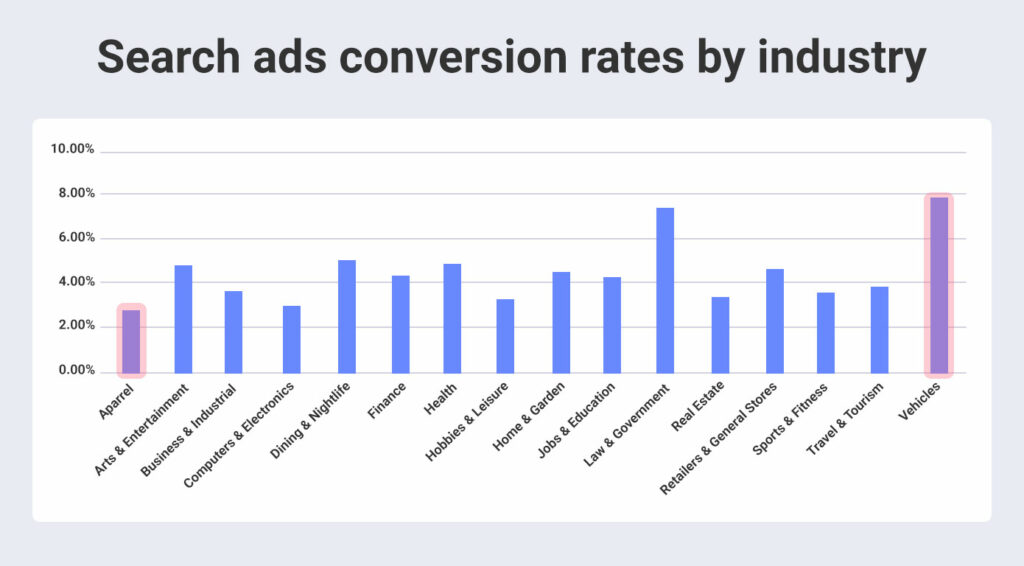
Source: Word Stream
By following many of the same best practices for display ads you can also improve your search ad performances. In addition, search ads have some other tactics you can utilize such as:
Ad extensions are an additional piece of information that let people take action directly from the search result. They could provide other links from your website, phone number, address, reviews, and more. Adding more useful information about your business via extensions can make your ads more visible, which leads to more clicks. Google reported having a 10-15% increase in CTR on average as a result of ad extension. And the good news is that ad extensions are completely free, clicks on your ads will be charged as usual.
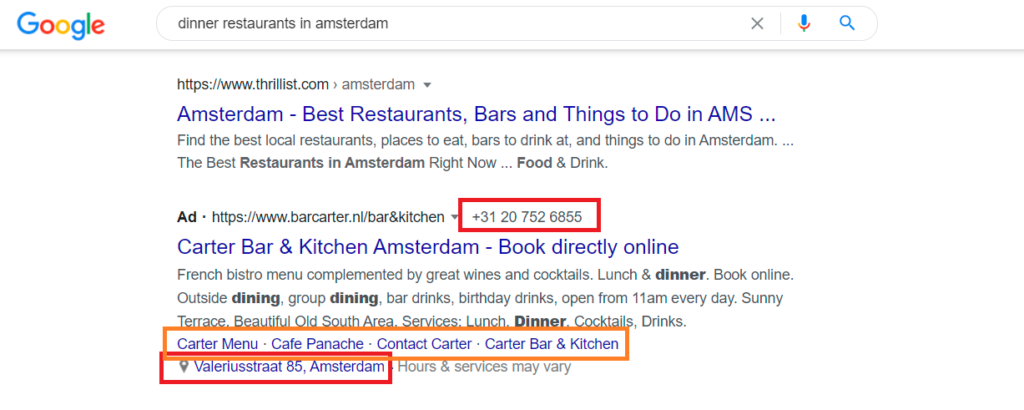
Smart Bidding is a subset of automated bid strategies that use machine learning to optimize for conversions or conversion value. There are a variety of smart bidding strategies, but to choose one, you should first define your goal as some might be great for your account, but others might be terrible. Learn more about each strategy from Google ads help center.
The pinning of headlines and descriptions is a feature of responsive search ads that allows you to pin any headlines and descriptions that must be displayed each time your ads are being displayed. That can improve your search ads performance as Google mixes and matches different headlines and descriptions based on search queries to best serve your users.
For best performance, highlight something different in each headline and description so a unique message is shown every time. In fact, Google won’t show your search ad if your headline and description are too similar.
Creating tighter ad groups can have a significant effect on your overall search ads performance. An ad group should consist of closely related keywords that speak to the same theme. Organizing your keywords in a tightly themed ad group will allow you to create more targeted ads, improve your account’s relevance, bring more qualified leads and lower your CPC.
Usually, Google places search ads on top of the search results, but sometimes on the bottom, too. On top of that, there might be other businesses that are paying to be shown in the search results for the same keywords as you do. Follow these 6 factors that Google considers when placing search ads and improve your rankings:
When you’re setting your ad bid, you’re telling Google how much you are willing to pay for a click on your ad, and usually, the higher the bid is, the higher you’ll rank. That probably doesn’t sound very appealing to you, especially if you have a tight budget, but is the quickest way to improve your search ad ranking.
Luckily though, you can choose to bid more only on specific high-value keywords relevant to your business and pay more only for those keywords that are of most value to you.
As mentioned above, aligning your ads and landing pages is a very important factor when it comes down to ranking and conversions. Some of the things that you should keep in mind when optimizing your landing page include making the landing page relevant, trustworthy, easy to navigate, and reliable, as well as making sure that your landing page matches your ad keywords, making it faster and mobile-friendly.
Ad Rank thresholds determine your ability to compete in an ad auction. If you don’t meet the threshold, your ad won’t be shown. Google doesn’t share much about the threshold except that it depends on the following factors:
If your ad is competing with another ad with a similar ad rank for the same position, the higher-ranking ad is more likely to win, but it also may have to pay a higher CPC. So, to make sure that you’ll be ahead of the competition, don’t forget to follow all these tips that will help you improve your competitiveness and therefore ranking.
This includes the person’s location, device, time of the search, the nature of the search terms, the other ads and search results that show on the page, and other user signals and attributes.
We’ve already covered this but is important to know that not only do extensions increase CTR, they also play a vital role in your ranking when Google Ads estimates how extensions and other ad formats you apply will impact your ad’s performance.
Knowing how to measure and improve the effectiveness of your marketing ads is a must for every marketing team. Understanding what you are doing right and what are you doing wrong will help you accelerate your overall marketing strategy and therefore increase your profits.
So, how are your marketing ads performing right now? What can you improve? From everything learned so far, what are you going to apply to your own campaigns?